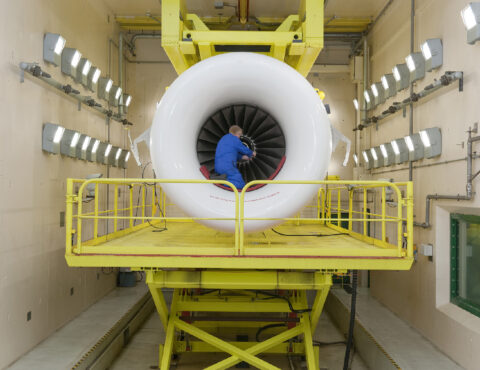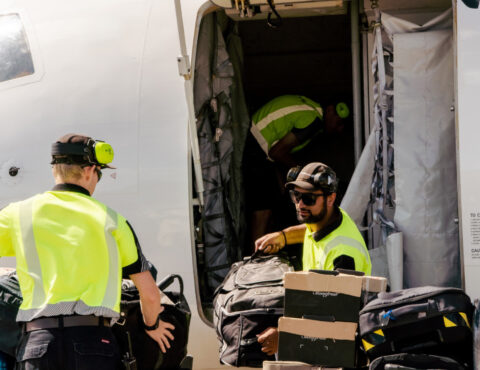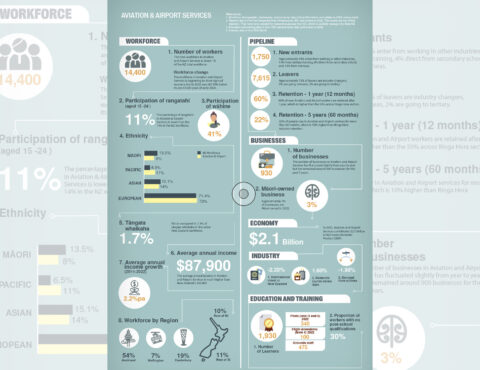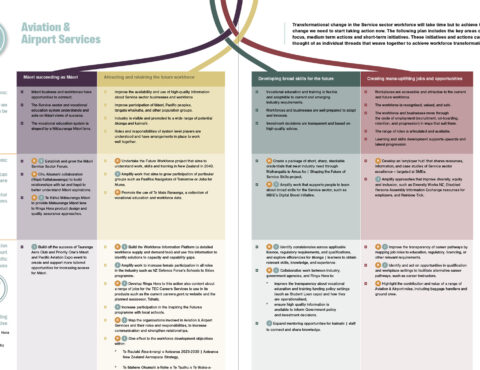Ringa Hora has worked with people from across industry to develop a shared roadmap to transform the Service sector workforce from its current state to the future that we aspire to.
The Workforce Development Plan looks across the Service sector and sets out the major factors shaping the sector and an overarching vision for the future.
Against that context, this Action Plan focuses on the characteristics and dynamics of the Aviation & Airport industry and its workforce. It describes what the future could look like for this workforce, the current challenges faced by the industry, and sets out the actions we can take to tackle this wero | challenge.
Ringa Hora’s Service Sector Workforce Development Plan is based on four aho | strands. Each of these aho will strengthen the workforce, but when woven together, as a taura whiri | rope, we can achieve real transformation of the workforce:
The Aho and actions outlined in this plan will support Aviation & Airport Services in delivering critical contributions to the domestic economy.
The industry provides vital connections for businesses, workers and communities to move people and goods around the motu and overseas. Keeping our skies safe and secure supports travel, tourism and various other businesses, as well as helping our diverse communities to connect with others.
There has been a rapid increase in demand for air travel following COVID-19. This demand can be met by ensuring the industry attracts and retains the right people with the skills and experience needed to deliver on required aviation regulations and practices.

The Aviation & Airport industry is made up of businesses involved in aircraft manufacturing and repair, airport operations, and air transport services.
The Aviation & Airport industry contributes $2.1B to the nation’s GDP and has wide ranging social and environmental impacts. The industry enables the success of other industries; for instance, airports are a major gateway for welcoming tourists to Aotearoa.
Work in this industry occurs across the motu and beyond. For example Airways is responsible for keeping 30 million square kilometres of airspace safe, including operating 19 air traffic control towers and two radar centres across the North and South Islands. There are pockets of concentrated regional activity, including in Marlborough where the Regional Skills Leadership Group has a focus on the aerospace industry.

To help us get to the future state, we need to understand and tackle the challenges that the Aviation & Airport Services industry faces, while also seizing the opportunities that already exist or are on the horizon. We’ve heard that the following factors are having a significant impact on the Aviation & Airport Services industry, including its approach to, and expectations of, workforce development.
Re-building industry and workforce capacity after COVID-19 contractions
The impact of COVID-19 and its subsequent recovery have not been experienced evenly across the industry. While passenger movement remained low until the full re-opening of borders in mid-2022, the freight industry had been considered an essential service and had already returned to 90% of pre-COVID-19 levels by December 2020. Many businesses are still in survival mode and working through immediate challenges. This includes facing increasing costs across all aspects of business, including the price of jet fuel increasing by 80% in the past three years, from (USD) $1.88 per gallon in 2019 to $3.37 in 2022.
Ensuring vocational education and training is fit for purpose and accessible
Filling critical capability gaps will require pathways through education to be accessible, flexible and adaptable. For example, aeronautical engineering needs to respond to and actively lead innovation through technology, such as, composites and Remotely Piloted Aircraft Systems. Removing cost barriers to entry will help encourage employers and workers to engage in training, especially flight training which is particularly costly for both the provider and the ākonga | learner.
The international student market is important to the on-going viability of flight training schools who also train domestic students. However, recent immigration changes (such as, work rights and residency pathways) may mean New Zealand is less attractive. These issues are at the interface of immigration and education policy settings, alongside the needs of people and workplaces, and requires attention to ensure the different perspectives and needs are understood.
Attracting people to the industry and retaining existing talent
Aviation & Airport Services has an ageing workforce, and a relatively limited flow of workers into the industry via the vocational education system. There have been particularly sharp decreases in the number of enrolments in flight attendant and ground staff qualifications in the wake of the pandemic. Overall, these flows into the Aviation & Airport industry may signal an untapped opportunity for attracting more rangatahi, but also showcase the importance of efforts to attract and support a wider range of people to transition into a new industry.
Talent attraction will be an ongoing problem if retention rates do not improve. Of people who joined the industry in 2015, only 60% remained after the first year, and 22% after five years. In contrast, some parts of the workforce are very loyal. For example, 73% of the aircraft manufacturing and repair workforce has only had one employer. We do not know the full reasons for these different dynamics, although can see that this is an ageing workforce which presents natural limits on retention (over half is older than 45, and 7% aged over 65).
There are approximately 14,400 people working in the Aviation & Airport industry. There are an exciting range of work opportunities, whether that’s on the ground or in the air, such as: logistics, refuelling, dispatching centres, doing weight and balance checks, air traffic control, baggage handlers,
check-in staff, flight attendants, pilots, and engineers who manufacture and maintain aircraft.
For the industry to successfully navigate the future changes there is a need to preserve long-held skills, while also being adaptable to advanced digital and automated technology.
New Zealand’s workforce is increasingly diverse. The industry will not be able to meet the growing demand for skills without actively increasing diversity in all roles within the industry. In addition, only 41% of the Aviation workforce are women. This drops to as low as 15% in aircraft manufacturing and repair. Increasing diversity makes businesses more attractive to potential kaimahi and customers, as well as creating economic and social benefits for employers, the workforce, and the wider community.
Using workforce participation data as a starting point shows there is work to be done in the Aviation & Airport Services industry to realise the aspirations and potential of Māori, Pacific peoples, and tāngata whaikaha | disabled people:
![]()
This industry has a relatively low proportion of Māori in the industry. The concentration of Māori within the Aviation & Airport industry has historically been centred in lower-paying roles, such as ground crew and baggage handlers, with a low representation in traditionally high-paying roles, such as air traffic controllers, pilots and engineers. The industry needs to build cultural competency within the workforce to retain diverse talent, support Māori and promote an environment where Māori feel reflected.
![]()
There are a large number of Pacific peoples in the Aviation & Airport Services industry, particularly in ground crew and baggage handler roles. Auckland is not only a ‘hub’ for the Pacific population but also for employment opportunities in the Aviation & Airport industry given the sizeable scale of Auckland Airport operations.5 Front line workers in aviation represent a pool of potential employees for higher skilled roles within the industry if pathways can be created.
![]()
Tāngata whaikaha includes physical, mental, intellectual, or sensory impairments which can impact a person’s life to varying degrees and in different ways. The industry is taking some
steps towards providing responsive services for tāngata whaikaha | disabled people as customers, such as many airports using the Hidden Disability Sunflower lanyard programme.6 However, businesses do not necessarily recruit or attract those same people to work in
the sector.

Explore the Aviation & Airport Services industry workforce demographic, business, and economy statistics, and education and training data.

Transformational change in the Service sector workforce will take time but to achieve that change we need to start taking action now. The Aviation & Airport action plan includes the key areas of focus, medium-term actions and short-term initiatives. These initiatives and actions can be thought of as individual threads that weave together to achieve workforce transformation.